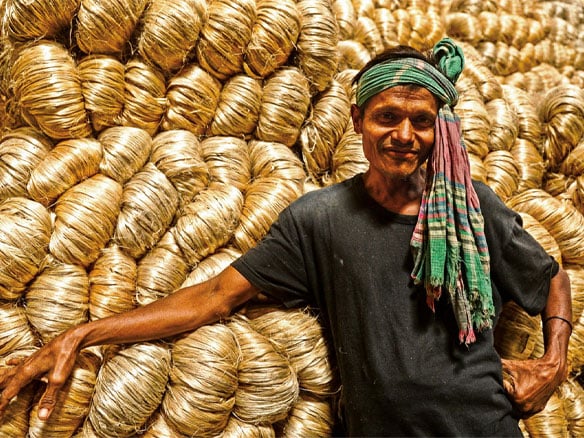Why is jute called the golden fiber of Bangladesh? Jute is deeply important to this South Asian nation’s culture, economy, and history, hence its fascinating title. Bangladesh has been identified with jute, a versatile and eco-friendly natural material, for millennia. The world trade industry has given Bangladesh a unique name: “The Golden Fiber.”
Bangladesh is a country in South Asia that is known for its rich cultural history and stunning natural beauty. But what is this “golden fiber” exactly, and why is it so important to Bangladesh’s economy and identity? This piece will talk about the interesting world of jute and explain why it is called the “Golden Fiber” of Bangladesh.This introductory inquiry will reveal the many meanings of this interesting name and how jute has affected the nation’s economy, environment, and traditions. Learn why jute is Bangladesh’s golden fiber on this voyage.
The History of Jute in Bangladesh
The stem of the jute plant (Corchorus olitorius and Corchorus capsularis) is used to get jute, a long, soft, and shiny vegetable fabric. It has been grown for hundreds of years in the Bengal area, which includes Bangladesh and West Bengal in India. Bangladesh has a long history of using jute. In the past, it was used to make ropes, textiles, and packing materials, among other things.
When the British were in charge of India as a colony, the demand for jute went through the roof. This caused jute mills to open in the Bengal area. Bangladesh quickly became a major export and production hub for jute, and the fiber’s many uses made the country’s economy very dependent on it. By the middle of the 20th century, jute was one of Bangladesh’s most important exports. It gave the country the name “Golden Fiber” in the area.
Growing Places
Tropical countries that get a lot of rain and are hot are good places for jute to grow. Bangladesh really is where the best grade and most jute are grown. About 80% of the world’s jute output comes from her. In addition to Bangladesh, India, Sri Lanka, Brazil, and Indonesia also grow jute. Most of the plants grow in Greater Mymensingh, Comilla, Faridpur, Pabna, Rangpur, and Rajshahi in Bangladesh.
How Important Jute Is to the Economy
Major Export Earner: Jute has been a very important part of Bangladesh’s economy and is one of its main exports. It has regularly been one of the country’s biggest exports, bringing in a lot of foreign currency.
Creating Jobs: The jute business gives millions of people in Bangladesh, especially those living in rural areas, jobs. From growing jute to preparing and making things out of it, the whole value chain helps people all over the country make a living.
Sustainable Crop: Jute is a sustainable crop because it doesn’t harm the earth and doesn’t need many chemicals to grow. Its cultivation also improves the health of the land and lowers carbon emissions, which is in line with today’s goals for sustainability.
Product Variety: Bangladesh has added more jute products to its line over the years. Besides being used to make sacks and bags, jute is now also used to make clothes, furniture, and even eco-friendly packing materials, which makes it even more valuable.
Climate and soil
It’s important for jute plants to grow in wet places, like swamps. Many lowlands in Bangladesh are submerged in water when it rains. This Bangladeshi wet and lowland land is perfect for growing jute.
Cultivation Method
Growing jute is a hard task. Before planting seeds, the ground is tilled, harrowed, and made rich with manure. If it rains in March or April, the seeds are usually planted shortly after. It is done several times to get rid of the weeds after the plants have grown a little. The plants are fully grown after three to four months. Once the plants are fully grown, they are cut down and put in water to die. While they were out in the sun drying. This is how the jute fabric is made ready to be sold and used.
Uses
You can make many things out of jute. Gunny bags, rope, rugs, coarse cloths, and mats are all things that it is usually used for. Painter’s brushes, school bags, fake hair, and many other household items are also made from it. Jute stems can be used for fencing and as firewood. They are now used to make partex and paper. The soft leaves are eaten as veggies. Jota is very useful for us because of this. Also, our scientists are working on making it more useful for us.
World Need for Jute
Bangladesh’s jute industry is known as the “Golden Fiber” not only because of its historical importance but also because jute goods are still in high demand around the world. Jute is good for the environment and breaks down naturally, which makes it a popular choice for eco-friendly people and businesses all over the world. The need for jute is growing as the world moves toward sustainability. This gives Bangladesh many chances to grow its exports and economy.
In the end
In conclusion, We all know Why is jute called the golden fiber of Bangladesh. Jute is vital to this South Asian nation’s culture, economics, and history, hence its intriguing name. This shows why jute is called the “golden fiber of Bangladesh.” Jute has been vital to the country’s economy, culture, and global trade, therefore its title is more than symbolic. Bangladesh, one of the world’s largest producers of jute, has used it to boost economic growth, employ millions, and promote sustainability.
Jute, used in textiles and packaging, represents sustainability and environmental responsibility. Its biodegradability and renewability make it a sustainable natural resource. Jute is also a source of national pride in Bangladesh due to its history and culture.
Bangladesh has improved the quality and competitiveness of its jute goods via innovative efforts, research, and worldwide alliances, ensuring a bright future for the golden fiber. Jute’s importance will expand as the globe seeks eco-friendly and sustainable alternatives. Thus, jute truly is the “golden fiber of Bangladesh,” representing economic prosperity and a dedication to a greener, more sustainable future.



